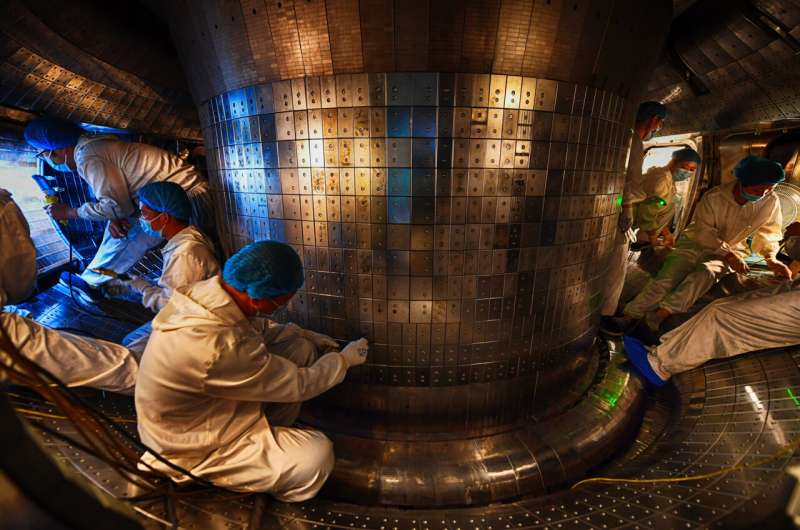This article has been reviewed according to Science X's editorial process and policies. Editors have highlighted the following attributes while ensuring the content's credibility:
fact-checked
peer-reviewed publication
trusted source
proofread
New super I-mode obtained on EAST

A new plasma operation scenario Super I Mode was discovered and demonstrated on the Experiment Advanced Superconducting Tokamak (EAST). The new high-confinement and self-organizing mechanism represents the reliability and advancement of the machine itself but also offers insights into how to better maintain the plasma and its operating stability.
The team from Institute of Plasma Physics, Hefei Institutes of Physical Science, CAS reported their findings in a recent paper published in Science Advances.
The exciting discovery was made during the EAST campaign last year in which a stationary plasma with a world-record pulse length of 1056 s was realized.
Scientists were surprised to find that compared with the I mode initially observed on other fusion devices, this new mode had even more dramatically improved the energy confinement, so it was called Super I mode.
The new mode attracted scientists' attention due to its exciting features. It demonstrated energy confinement much higher than I-mode and was comparable to H-mode. During long-term high plasma performance, the heat load on components exposed to high temperature plasma was moderate due to the absence of large edge-localized-modes.
After data analysis, scientists understood the reasons for the significantly enhanced energy confinement.
"We have maintained the electron internal transport barrier at the plasma center," explained Dr. Zhang Bin, an operator on the EAST team, "which worked together with I-mode at the edge, then energy was greatly confined."
In addition to improved energy confinement, the Super I mode also has advantages over other scenarios, such as no metallic impurity central accumulation at the core, the particle flux on the divertor remained extremely stable, and sustained quiet stationary plasma-wall interactions. Overall, it could become the basic operation scenario of ITER, the world's largest tokamak.
An advanced and open experimental platform
Fusion is the process of two atoms of hydrogen fusing together to form an atom of helium while releasing a large amount of energy, through which the sun and stars are powered.
Fusion scientists who are trying to replicate the sun's power on earth want the fusion reaction to take place in a well-controlled way. They hope that eventually society could be powered in totally new but much more efficient and green way.
Scientists around the world have been exploring this problem in different ways for decades. Dozens of fusion research machines have been designed and constructed and operated as result.
EAST is one of those experimental platforms that was built with the goal of addressing key technological and physics issues of long-pulse operations. It takes Tokamak as its technological route and applies a magnetic configuration like ITER that is so far one of the most extensive international scientific collaborations, involving 35 countries and spanning 35 years.
Since its first discharge in 2006, EAST has two rounds of campaigns each year. Thousands of experiments were conducted independently by its in-house group or collectively with international fusion community.
Last year, the machine achieved a plasma temperature of 120 million degrees Celsius for 101 seconds in May. Shortly after, it embraced its one hundred thousandth shot, followed by a record-long 1,056 s for high temperature tokamak plasma at the end of the same year.
Spurred by the record long plasma operation, scientists buried themselves immediately into data analysis. They wanted more from the "story behind the record," said Prof. Qian Jinping, deputy head of Tokamak Experiment Division. "We were all excited about the record. That was for sure a milestone of our machine. But I think what the experiment inspires us was more worth expectation," added Qian.
As an advanced experimental platform, the machine plays an essential role in the exploration of fusion physics, technology and engineering. Earlier this year, EAST and its international collaborators proved experimentally, for the first time, the current driven by turbulence, via observed data obtained in the latest experiment and subsequent simulations.
"The machine enables possibility that we testify ideas, observe physical phenomenon, then we analyze the data to know why," Qian said, elaborating on how an advanced experimental platform facilitates research "every step forward."
More information: Yuntao Song et al, Realization of Thousand-Second Improved Confinement Plasma with Super I-Mode in Tokamak EAST, Science Advances (2023). DOI: 10.1126/sciadv.abq5273. www.science.org/doi/10.1126/sciadv.abq5273
Journal information: Science Advances
Provided by Chinese Academy of Sciences





















